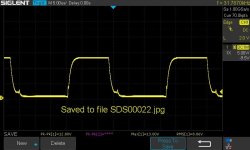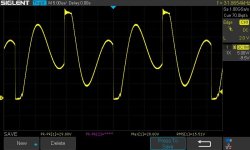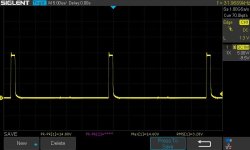The duty cycle goes from like 90% to 0% between 13.5 and 13.6V. I have to use the fine adjustment on the supply to see it.
Good question. Aparrently neither. But the drive waves are going nuts above 13.6. Here are gate and drain waves respectively below 13.6, and above 13.6.
In both cases, audio is passing and rail voltage is steady.
In both cases, audio is passing and rail voltage is steady.
Attachments
Did you re-set the bias?
This is a regulated power supply and the supply will roll back the duty cycle as soon as the rail voltage reaches the target rail voltage. If nothing is pulling the rail voltage down (no bias current or power output), the duty cycle will go to near 0%. You will see the drive better on pins 9 and 10 of the 494.
This is a regulated power supply and the supply will roll back the duty cycle as soon as the rail voltage reaches the target rail voltage. If nothing is pulling the rail voltage down (no bias current or power output), the duty cycle will go to near 0%. You will see the drive better on pins 9 and 10 of the 494.
Yea, I reset the bias and applied some power (maybe 10-15 watts) but the waveforms still look messed up. The amp is functioning OK though....
It's a good thing you replied quickly. With all of the questions and tests, this would have taken months if there were only 1 or 2 replies a day.
Quite interesting. Used to be a rockford sales guy / installer and was told, and thus told customers, they were not regulated.
Thank you so much Perry, you made a new teenage driver who was beating himself up over this reverse polarity mishap a happy dude. He learned his lesson and I learned a few myself. Your methodical approach is second to none and a huge asset to this community. Cheers!
I'm pretty sure he has a 150A breaker, but it's probably too big, or faulty. But yea, he needs some adult supervision for the time being.
It needs a 30 amp fuse. Unless he's abusive, he shouldn't need to go any higher. Use a MAXI-Fuse.
Curious about the regulation aspect so I ran a test. It is unregulated under 13.8 volts B+ based on the clipping / max output being proportional to B+. But it starts limiting the rails above 13.8v B+. It appears regulation doesn't start happening until B+ (or rails) goes above a certain limit. It's regulating down for a higher B+, but not up for lower B+. I would call this a limiter more than a regulator, at least in the sense regulation doesn't happen unless B+ is high enough.
Last edited:
It's not generally practical for the transformer winding ratio to be so high that it can reach the target rail voltage at any DC input voltage. Some amps do it but it's not generally practical.
With the regulation that this amp has, it limits the rail voltage to a point that the output transistors won't fail due to having to dissipate more power than they can handle.
In some amps, the regulation prevents the rail voltage to go above the working voltage of the rail caps. This allows them to use the highest possible capacitance. This amp uses 50v caps so voltage isn't a concern for the caps.
With the regulation that this amp has, it limits the rail voltage to a point that the output transistors won't fail due to having to dissipate more power than they can handle.
In some amps, the regulation prevents the rail voltage to go above the working voltage of the rail caps. This allows them to use the highest possible capacitance. This amp uses 50v caps so voltage isn't a concern for the caps.
Do you know if the JL slash series were "fully regulated"? For example 12v B+ or 14v B+ you get the same output? This is what I remember being the case in my previous life.
I don't know about all of them but the JL 500 did appear to have a high enough ratio, along with a low-voltage protection, ensured that the rail voltage could be reached in all conditions. The high ratio is why they use 400v rectifiers in an amp with 80v of rail.
- Home
- General Interest
- Car Audio
- Punch X360.2 schematic / advice




